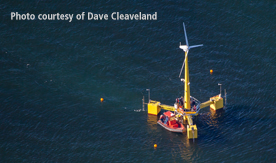
DOE Officials Mark Yearlong Deployment of VolturnUS, Sign $3.97M Cooperative Research Agreement
Editor’s note: This is an edited version of the original story.
U.S. Sen. Susan Collins and U.S. Rep. Michael Michaud welcomed top officials from the U.S. Department of Energy (DOE) to Castine on Sept. 5 to celebrate a successful year of the VolturnUS floating wind turbine deployed off Castine.
“This anniversary is another great day for our state, the university and its many partners, and for the advancement of clean, renewable energy for our nation,” said Collins. “This is a remarkable achievement and confirms my belief that the most innovative and dedicated wind energy researchers in the world are working right here in Maine.”
Michaud said the VolturnUS wind turbine is an incredible project and a great example of the type of forward-thinking ideas that can strengthen our economy in the years to come and define Maine as a leader in innovative technologies.
“The UMaine team has done incredible work to get not just VolturnUS up and running, but many other promising initiatives as well. I look forward to continuing to partner with them on advancing these projects that will strengthen Maine’s economy,” he said.
The federal officials were joined by representatives from the University of Maine, Maine Maritime Academy and Cianbro, who discussed highlights of the yearlong deployment off the coast of Castine. VolturnUS, a one-eighth scale model of a 6 MW floating wind turbine with more than 50 sensors on board, has been successfully operating and collecting data related to design capabilities for more than a year, including throughout the Maine winter.
Among the data highlights:
- The VolturnUS 1:8 successfully withstood 18 severe storms equivalent to 50-year storms, and one 500-year storm.
- The maximum acceleration measured was less than 0.17 g for all 50- and 500-year storms, which matched numerical predictions.
- The maximum tower inclination angle measured was less than 7 degrees in all 50- and 500-year storms, and these numbers matched predictions.
In addition, as part of the event, DOE Assistant Secretary for Energy Efficiency and Renewable Energy David Danielson signed a $3.97 million cooperative research agreement with UMaine, of which is $3 million in DOE funding and $970,000 in cost share, to continue the design and engineering work of the full-scale VolturnUS floating hull.
The other members of the Congressional Delegation also sent congratulations on the VolturnUS project.
“I am pleased to offer my congratulations to the University of Maine as it welcomes this important award and celebrates more than a year of continued success by VolturnUS. This pioneering project represents the next generation of wind technology, and it has the potential to revolutionize how we think about and how we utilize our energy resources. Today’s investment by the Department of Energy is another milestone in its progress and is a renewed recognition of the excellent work done by so many across Maine who will continue to strive to secure a more sustainable and environmentally friendly energy future through VolturnUS,” said Sen. Angus King.
“This project is an example of two of Maine’s most valuable resources at work: offshore wind that can become a new source of clean energy and the ingenuity and technical skill that can harness that wind. Maine is uniquely positioned to be a leader in offshore wind technology and this successful demonstration project is proof of that,” said Rep. Chellie Pingree.
“We appreciate the continued support of the Department of Energy in the University of Maine’s ongoing efforts in deepwater offshore wind technology research and development,” said UMaine President Susan Hunter. “It’s through partnerships like this in the federal, state, education and industry sectors that the University of Maine most efficiently and effectively addresses the needs of the state.”
The VolturnUS floating turbine is a patent-pending technology developed at the University of Maine Advanced Structures and Composites Laboratory by UMaine and Cianbro personnel. In June 2013, it became the first grid-connected offshore wind turbine deployed in the Americas, and the first floating turbine in the world designed using a concrete hull and a composites material tower to reduce costs and create local jobs. The turbine is a 1:8 geometric scale test program to prepare for the construction of a larger 6 MW floating turbine. The project brought together more than 30 organizations as part of the DeepCwind Consortium, led by UMaine and funded through a competitive DOE grant and industry contributions.
“The success of the VolturnUS 1:8 test project deployed off Castine is a critical milestone on our path to allow us to economically harness the enormous wind power far offshore the U.S.” said Habib Dagher, director of UMaine’s Advanced Structures and Composites Center. “The VolturnUS concrete floating hull technology has the potential to harness over 50 percent of the U.S. 4,000 GW offshore wind resource. With 156 GW of offshore wind capacity off the Maine coast, and 4,000 GW off the U.S. coast, we have an opportunity to reduce our reliance on fossil fuels, stabilize energy prices over the long run, help protect the environment, stimulate local economic activity and create a new industry.”
Contact: Joshua Plourde, 207.581.2117
